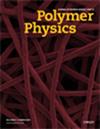Physical gelation of melamine formaldehyde resin solutions. II. A combined light‐scattering and low‐resolution relaxation proton NMR study
3区 工程技术
Q1 Materials Science
Journal of Polymer Science. Part B, Polymer Physics
Pub Date : 1999-12-01
DOI:10.1002/(SICI)1099-0488(19991201)37:23<3307::AID-POLB6>3.0.CO;2-#
引用次数: 20
Abstract
The kinetics of physical gelation in aqueous melamine formaldehyde (MF) resin solutions were studied with the aid of low-resolution 1H NMR T2 relaxation experiments in combination with both static and dynamic light-scattering measurements. The investigations were conducted on a series of MF resins with increasing degrees of condensation. We show that MF aggregates (aided by hydrogen bonds) were immediately formed upon cooling from reaction to room temperature, that is, storage temperature. Surprisingly, the growth of these aggregates, which eventually led to the formation of a physical gel, did not have a major effect on molecular mobility. By means of light-scattering experiments, we were able to monitor the increase of the size of MF aggregates as a function of storage time. The physically gelled MF solutions were subjected to heating and subsequent cooling runs and again studied by light-scattering and nuclear magnetic resonance (NMR) experiments. MF aggregates were destroyed, depending on the degree of condensation, in the temperature range 35–60 °C according to NMR, and 40–75 °C as determined by light scattering. The process of physical gelation was reversible; upon subsequent cooling, the MF aggregates were formed anew. © 1999 John Wiley & Sons, Inc. J Polym Sci B: Polym Phys 37: 3307–3318, 1999三聚氰胺甲醛树脂物理胶凝溶液。2结合光散射和低分辨率弛豫质子核磁共振研究
采用低分辨率1H NMR T2弛豫实验,结合静态和动态光散射测量,研究了三聚氰胺甲醛(MF)树脂水溶液中的物理凝胶动力学。对一系列缩合度增大的MF树脂进行了研究。我们表明,MF聚集体(氢键辅助)在从反应冷却到室温(即储存温度)后立即形成。令人惊讶的是,这些聚集体的生长,最终导致了物理凝胶的形成,并没有对分子迁移率产生重大影响。通过光散射实验,我们能够监测到MF聚集体的大小随储存时间的增加。物理凝胶化的MF溶液进行加热和随后的冷却运行,并再次通过光散射和核磁共振(NMR)实验进行研究。根据核磁共振,MF聚集体在35-60°C的温度范围内被破坏,根据光散射,在40-75°C的温度范围内被破坏,这取决于凝结的程度。物理凝胶化过程是可逆的;在随后的冷却过程中,中温聚集体重新形成。©1999 John Wiley & Sons, Inc[J] .高分子材料学报,1999,19 (3):387 - 398
本文章由计算机程序翻译,如有差异,请以英文原文为准。
求助全文
约1分钟内获得全文
求助全文
来源期刊
CiteScore
5.90
自引率
0.00%
发文量
0
审稿时长
2.1 months
期刊介绍:
Since its launch in 1946 by P. M. Doty, H. Mark, and C.C. Price, the Journal of Polymer Science has provided a continuous forum for the dissemination of thoroughly peer-reviewed, fundamental, international research into the preparation and properties of macromolecules.
From January 2020, the Journal of Polymer Science, Part A: Polymer Chemistry and Journal of Polymer Science, Part B: Polymer Physics will be published as one journal, the Journal of Polymer Science. The merged journal will reflect the nature of today''s polymer science research, with physics and chemistry of polymer systems at the heart of the scope.
You can continue looking forward to an exciting mix of comprehensive reviews, visionary insights, high-impact communications, and full papers that represent the rapid multidisciplinary developments in polymer science.
Our editorial team consists of a mix of well-known academic editors and full-time professional editors who ensure fast, professional peer review of your contribution. After publication, our team will work to ensure that your paper receives the recognition it deserves by your peers and the broader scientific community.

 求助内容:
求助内容: 应助结果提醒方式:
应助结果提醒方式:


